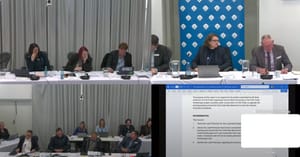Despite ongoing protests, including from local Prom Coast CFAs, the state government is forging ahead with its Emergency Services Levy, albeit with some concessions. It remains for South Gippsland Shire Council to implement the levy, but in last week’s meeting, it appears they will not go down without a fight.
Councillors fired a shot across the bow of the state government, unanimously passing a motion that maintains its opposition to the controversial Emergency Services Volunteer Fund (ESVF) levy while acknowledging the inevitable reality of its implementation.
At last Wednesday’s council meeting, councillors grappled with the frustrating position of being forced to collect a levy they fundamentally oppose, with the phrase “this is happening to us whether we like it or not” echoing through the chambers.
According to figures published by the Council, the new levy will extract approximately $1.3 million from South Gippsland ratepayers in 2025/26 – a figure reduced from an initial $5 million following drought relief exemptions for around 3,200 local farmers. However, the relief for farmers has not been extended to residential properties, which face a doubling of rates, while approximately 400 local businesses confront significant increases.
Councillor Sarah Gilligan led the charge with an amended motion demanding the Premier ensure transparent accounting of all funds collected from local ratepayers. “Council strongly urges that all funds collected from South Gippsland be transparently accounted for and publicly reported,” the motion states.
The council’s concerns centre on what they believe is the fundamental inequity of the levy structure. The current model places a disproportionate burden on regional producers through different calculations for agricultural and commercial rates, while offering no guarantee that funds collected from rural areas will be reinvested in those same communities.
“This money is not for general revenue. This isn’t to pay down debt. You’ve said it’s for the emergency services and I’d like to ensure it goes there,” Councillor Scott Rae told the meeting, voicing the skepticism many feel about where the money will actually end up.
Adding salt to the wound, councils will be required to collect the levy on behalf of the state government but it appears they will have no control over how funds are distributed, effectively making local councils tax collectors for a policy they oppose, while stripping them of any influence over how their communities’ contributions are spent.
Councillor Nathan Hersey highlighted the broader implications: “Not only is this impacting our community and our people and our local economy, but we as a Council, it is having an impact on us as an organisation. This will continue to impact our bottom line.”
The council is pushing for legislative reform that would allow them to prioritise collecting their own rates and charges before handing over state-imposed levies. They’re also demanding clear distinction on rate notices between council charges and state levies, ensuring ratepayers know exactly where their money is going.
There may also be mounting administrative headaches as the Council implements
the new levy. The changes could require significant software updates and staff training to handle new property classifications and rate types, including the distinction between Principal Place of Residence and Non-PPR properties.
According to the council report, customer service teams are already buckling under increased call volumes and complaints from confused and frustrated ratepayers grappling with payment obligations and levy increases.
While $4 million has been allocated statewide to help councils implement these changes, South Gippsland’s share remains unknown – though they currently receive $70,000 annually to collect the existing Fire Services Levy. It is unknown if this sum will cover the administrative burden of this new system. Cara Schultz






